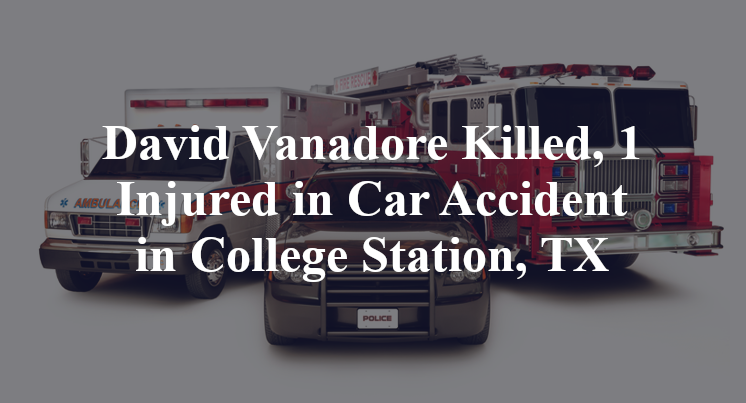David Vanadore Killed, 1 Injured in Car Accident in College Station, TX
College Station, TX — October 2, 22025, David Vanadore was killed and another person was injured in a car accident sometime in the afternoon on State Highway 30.
According to authorities, 68-year-old David Vanadore was traveling in an eastbound Ford F-150 pickup truck on S.H. 30 near the Hardy Weedon Road intersection when the accident took place.

Officials indicate that, for as yet unknown reasons, a collision took place between the front-end of the pickup truck and the rear-end of a Nissan Armada that had also been traveling eastbound. After the initial collision, the pickup truck veered into the westbound lanes; there, it was involved in a secondary collision with an oncoming SUV.
Vanadore and one person who had been in the SUV suffered critical injuries over the course of the accident; they were each transported to area medical facilities by EMS in order to receive immediate treatment. However, Vanadore was unable to overcome the severity of his injuries, having later been declared deceased.
Additional details pertaining to this incident are not available at this point in time. The investigation is currently ongoing.
Commentary
When a crash involves multiple impacts and leaves someone dead, it’s rarely the result of a single simple mistake. Chain-reaction collisions often raise complex questions about timing, mechanical response, and whether each vehicle involved performed as it should have. Finding those answers takes a level of investigative depth that goes far beyond a standard scene report.
Did the authorities thoroughly investigate the crash?
A three-vehicle collision like this one demands a complete reconstruction. Did investigators use mapping tools or event diagramming to understand how the first impact led to the second? Was there an effort to determine whether the Ford F-150 braked or attempted to steer away before striking the Armada? When a crash sequence unfolds across lanes, every fraction of a second matters, and determining what each driver did—or was able to do—requires careful review. The thoroughness of that process depends heavily on the investigators’ training and whether they had access to proper reconstruction resources.
Has anyone looked into the possibility that a vehicle defect caused the crash?
In crashes involving multiple impacts, it’s worth asking whether something in the vehicle’s mechanical or electronic systems contributed to the outcome. A braking failure, throttle issue, or airbag malfunction could all affect how the crash unfolded. The Ford F-150, like many newer trucks, depends on advanced systems such as automatic braking and stability control—systems that can fail without leaving obvious signs. Unless both vehicles were examined for mechanical or electronic issues, a contributing defect might never come to light.
Has all the electronic data relating to the crash been collected?
Modern vehicles often store critical information from the seconds before impact: speed, throttle, braking, and steering activity. Reviewing that black box data could show whether the F-150 tried to slow down before striking the Armada, or if the truck’s systems didn’t respond properly. The same applies to the SUV involved in the secondary collision. Phones, GPS logs, or nearby traffic cameras might also capture information that helps clarify sequence and timing. Without those digital records, much of what truly happened remains unknown.
When a crash claims a life, surface explanations are never enough. Only by examining every layer of mechanical and electronic evidence can investigators reach a clear, factual understanding of what took place.
Takeaways:
- Multi-vehicle collisions require full reconstruction to understand sequence and timing.
- Vehicle malfunctions, including braking or stability system failures, could have shaped the outcome.
- Black box data and other electronic evidence are key to revealing how the crash unfolded.

*We appreciate your feedback and welcome anyone to comment on our blog entries, however all visitor blog comments must be approved by the site moderator prior to showing live on the site. By submitting a blog comment you acknowledge that your post may appear live on the site for any visitors to see, pending moderator approval. The operators of this site are not responsible for the accuracy or content of the comments made by site visitors. By submitting a comment, blog post, or email to this site you acknowledge that you may receive a response with regard to your questions or concerns. If you contact Grossman Law Offices using this online form, your message will not create an attorney-client relationship and will not necessarily be treated as privileged or confidential! You should not send sensitive or confidential information via the Internet. Since the Internet is not necessarily a secure environment, it is not possible to ensure that your message sent via the Internet might be kept secure and confidential. When you fill out a contact or comment form, send us an email directly, initiate a chat session or call us, you acknowledge we may use your contact information to communicate with you in the future for marketing purposes, but such marketing will always be done in an ethical way.